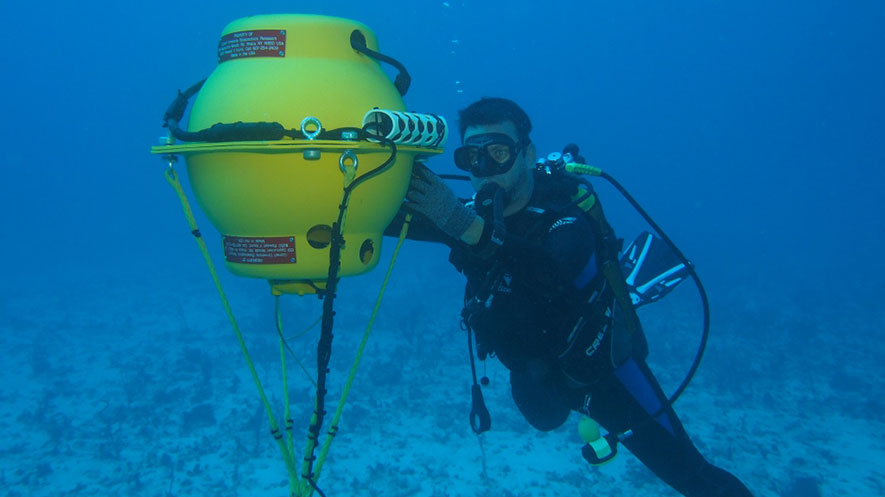NOAA scientists studying sounds made by Atlantic cod and haddock at spawning sites in the Gulf of Maine have found that vessel traffic noise is reducing the distance over which these animals can communicate with each other. As a result, daily behavior, feeding, mating, and socializing during critical biological periods for these commercially and ecologically important fish may be altered, according to a study published in Nature Scientific Reports.
Three sites in Massachusetts Bay, two inside Stellwagen Bank National Marine Sanctuary (SBNMS) and one inshore south of Cape Ann, were monitored for three months by researchers at the Northeast Fisheries Science Center (NEFSC) laboratory in Woods Hole, Mass. and at the sanctuary offices in Scituate, Mass. Vocalizations, such as Atlantic cod grunts and haddock knocks, were recorded by bottom-mounted instruments at each site during spawning in winter and spring.
“We looked at the hourly variation in ambient sound pressure levels and then estimated effective vocalization ranges at all three sites known to support spawning activity for Gulf of Maine cod and haddock stocks,” said Jenni Stanley, a marine research scientist in the passive acoustics group at the NEFSC and SBNMS and lead author of the study. “Both fluctuated dramatically during the study. The sound levels appear to be largely driven by large vessel activity, and we found a signification positive correlation with the number of Automatic Identification System (AIS) tracked vessels at two of the three sites.”
Audio clips
Cod grunts
Haddock knocks
Vessel moving away
AIS is an automatic tracking system, used on ships and by vessel traffic services. It provides information on a vessel, such as its unique identification number, position, course and speed, which can be displayed on a shipboard radar or electronic chart display.
Ambient sounds - those in the surrounding environment - include animals vocalizing, physical sounds such as wind and water movement or geological activity, and human-produced sound from ships and marine construction. Many marine animals use ambient sound to navigate, to choose where to settle, or to modify their daily behaviors including breeding, feeding and socializing.
Cod grunts were present for 100 percent of the spring days and 83 percent of the winter days. Haddock knocks were present for 62 percent of the winter days within the three-month sampling period. However, ambient sound levels differed widely at the three sites, both on an hourly and daily time scale. The Atlantic cod winter spawning site, nearest the Boston shipping lanes, had the highest sound levels, while the Atlantic cod spring spawning site inshore south of Gloucester, Mass. had the lowest. Sound levels in the haddock winter spawning site, further offshore in the sanctuary, were in the middle of the range detected in the study.
Study data were also used to calculate the estimated distance a fish vocalization would be heard at each of the spawning sites. The effective radius ranged widely, from roughly 4 to 70 feet, and was largely dependent on the number of tracked vessels within a 10 nautical mile radius of the recording sites.
Lower-level, chronic exposure to increased ambient sound from human activities is one of the most widespread, yet poorly understood, factors that could be changing fish behavior. If they cannot hear as well as they need to, then sound signals from other fish can be lost, compromised, or misinterpreted in ways that can cause a change in behavior. Since Atlantic cod, for example, vocalize to attract mates and listen for predators, not hearing those signals could potentially reduce reproductive success and survival.
“Anthropogenic sound in certain ocean regions has increased considerably in recent decades due to various human activities such as global shipping, construction, sonar, and recreational boating,” Stanley said. “As ocean sound increases, so does the concern for its effects on populations of acoustic signalers, which range from invertebrates to marine mammals. We don’t know if or to what extent specific species can adapt or adjust their acoustic signals to compete in this environment.”
In addition to Stanley, other researchers involved in the study were Sofie Van Parijs at the NEFSC’s Woods Hole Laboratory and Leila Hatch at Stellwagen Bank National Marine Sanctuary. Funding was provided by NOAA Fisheries’ Northeast Fisheries Science Center (NEFSC) and Regional Office, NOAA’s Office of National Marine Sanctuaries, the National Oceanographic Partnership Program, and the Massachusetts Environmental Trust.



